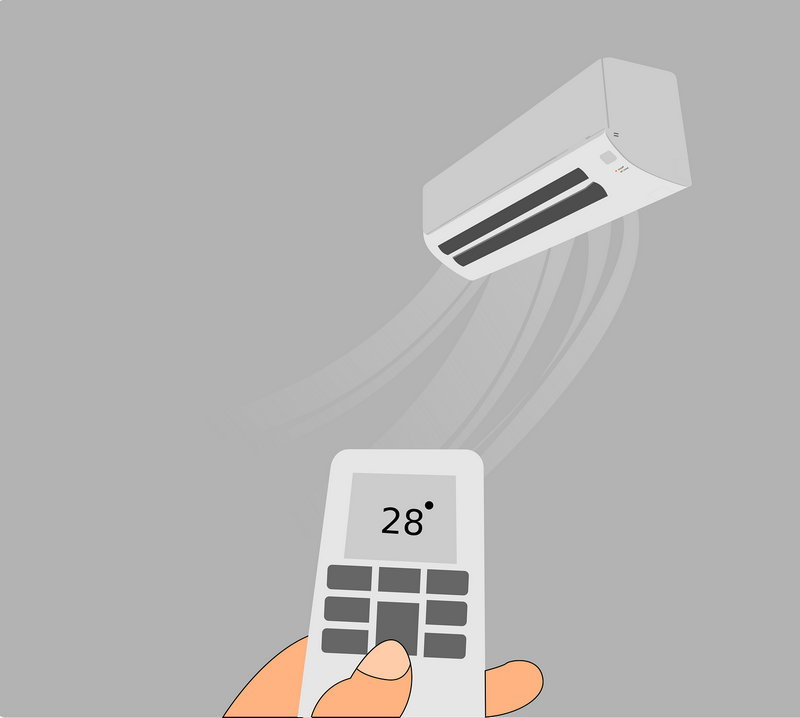
Which is better window or split AC?
When it comes to cooling our homes or offices, there are two popular choices – window AC and split AC. Both of these options have their own pros and cons, making it difficult to determine which one is better. In this article, we will discuss the advantages and disadvantages of both types of AC units, helping you make an informed decision.
A window AC is a self-contained unit that is installed in a window or a hole in a wall. It is compact and easy to install, making it a popular choice for smaller spaces. With its all-in-one design, a window AC unit is cost-effective and efficient, as it doesn’t require any additional ductwork or installation.
On the other hand, a split AC consists of two main units – the indoor unit and the outdoor unit. The indoor unit is usually installed on a wall, while the outdoor unit is placed outside the building. Split AC units provide better air distribution and are quieter compared to window AC units.
Both window AC and split AC have their own pros and cons, and the choice between the two depends on various factors such as the size of the space, budget, and personal preference. It is essential to consider these factors and weigh the advantages and disadvantages before making a decision on which type of AC unit is better for you.
Window AC Pros
- Easy installation: Window AC units are relatively easy to install, especially compared to split AC systems. They can be mounted directly in a window or through a hole in the wall.
- Cost-effective: Window AC units are generally more affordable than split AC systems. They are a popular choice for budget-conscious consumers.
- Space-saving: Since window AC units are installed in a window or wall, they do not take up valuable floor space like split AC systems.
- Energy-efficient: Window AC units are designed to cool a specific area, allowing for greater energy efficiency compared to cooling an entire home or building with a split AC system.
- Convenient maintenance: Window AC units are easier to access for maintenance and cleaning. Filters can be easily removed and cleaned, ensuring optimal performance and air quality.
- Portability: Window AC units are relatively lightweight and can be easily moved from one location to another, making them convenient for renters or those who frequently change residences.
Window AC Cons
While window AC units have their advantages, there are also some downsides to consider.
1. Window Placement: One major drawback of window AC units is that they require a window for installation. This can limit their placement options and may not be suitable for every room in your home.
2. Noise Level: Window AC units tend to be noisier compared to split AC units. The compressor and fan motor are located in the same unit, and the noise can be distracting, especially if you are using the AC in your bedroom or living room.
3. Design: Window AC units can be less aesthetically pleasing compared to split AC units. They protrude from the window, disrupting the exterior appearance of your home. Additionally, they can block the natural light and the view from the window.
4. Cooling Capacity: Window AC units generally have a lower cooling capacity compared to split AC units. If you have a larger space or live in a hotter climate, a window AC unit may not be able to provide sufficient cooling.
5. Energy Efficiency: Window AC units are typically less energy-efficient compared to split AC units. They may consume more electricity and result in higher energy bills, especially if used for extended periods of time.
Overall, while window AC units can be an affordable and convenient cooling option, split AC units are generally considered better due to their flexibility in placement, lower noise level, better design, higher cooling capacity, and higher energy efficiency.
Split AC Pros
When comparing window AC and split AC, there are several advantages that make split AC a better option:
- Efficient Cooling: Split AC units provide better cooling efficiency compared to window ACs. They are designed to effectively cool larger spaces and distribute air evenly.
- No Noise Inside: Unlike window ACs, split ACs have their compressor unit placed outside the room. This eliminates the noise from the compressor, allowing for a quieter indoor environment.
- Better Air Quality: Split ACs have a built-in filtration system that helps remove dust, pollen, and other contaminants from the air. This improves the overall air quality and can be beneficial for people with allergies or respiratory conditions.
- Aesthetic Appeal: Split ACs are more aesthetically pleasing as they only have a sleek indoor unit visible inside the room. The outdoor unit can be installed outside the building or concealed, making it less obtrusive.
- Multiple Indoor Units: Split ACs can be connected to multiple indoor units, allowing for cooling different rooms or zones with individual temperature controls.
- Energy Efficiency: Split ACs are generally more energy-efficient than window ACs. They come with inverter technology that adjusts the compressor speed based on cooling needs, resulting in energy savings.
Considering these advantages, split ACs offer a better cooling solution compared to window ACs with their improved efficiency, noise reduction, air quality enhancement, aesthetic appeal, and energy efficiency.
Split AC Cons
The following are some of the disadvantages of using a split AC:
- Higher initial cost: Split AC systems tend to be more expensive than window AC units.
- Installation complexity: Split ACs require professional installation due to the complexity of the unit, including both indoor and outdoor components.
- Limited portability: Split ACs are fixed in one spot and cannot be easily moved from room to room.
- Lack of flexibility: Split ACs are generally designed to cool a specific area, limiting their ability to provide cooling to multiple rooms simultaneously.
- Higher maintenance cost: Split ACs may require more regular maintenance and servicing, adding additional costs over time.
- Noisier operation: Split ACs are known to produce more noise compared to window ACs, which can be bothersome for some users.
- Higher energy consumption: Split ACs often consume more electricity compared to window ACs, resulting in higher energy bills.
Despite these drawbacks, split ACs offer several advantages in terms of their cooling efficiency, aesthetics, and noise reduction. However, the decision on whether a split AC or window AC is better ultimately depends on individual needs and preferences.
Energy Efficiency
When it comes to energy efficiency, split ACs are generally considered better than window ACs. Split ACs have the advantage of being able to cool individual rooms rather than the entire space, allowing for more efficient cooling. They also tend to have higher energy efficiency ratings, meaning they consume less energy to produce the same cooling effect as window ACs.
Window ACs, on the other hand, are known to be less energy efficient compared to split ACs. They typically have lower energy efficiency ratings and are less effective at cooling larger spaces. Window ACs also tend to leak energy due to poor insulation around the unit, causing higher energy consumption.
In summary, if energy efficiency is a priority for you, split ACs are the better choice. They are more effective at cooling individual rooms and consume less energy compared to window ACs.
Window AC Energy Efficiency
When comparing the efficiency of window AC units versus split AC units, it is generally agreed upon that split ACs are more energy efficient. This is due to the design of split AC systems, which can allow for more precise cooling and climate control.
Split ACs have separate units for the indoor and outdoor components, which allows for greater flexibility in terms of installation and operation. The indoor unit can be placed in the room or area that needs cooling, while the outdoor unit can be installed in a location that facilitates proper ventilation and heat dissipation.
On the other hand, window AC units are typically installed in a window or through a hole in the wall. This design can lead to air leakage and poor insulation, resulting in a higher energy consumption. Additionally, window AC units may struggle to effectively cool larger areas or multiple rooms, which can further contribute to inefficiencies.
Furthermore, split AC units often come with advanced features such as programmable thermostats and inverter technology, which optimize energy usage and reduce power consumption. These features allow the split AC to adjust its cooling capacity according to the desired temperature, resulting in better energy efficiency.
In conclusion, when it comes to energy efficiency, split AC units are generally considered better than window AC units. The separation of indoor and outdoor components, improved insulation, and advanced features make split AC units more efficient in cooling and climate control. However, it is important to consider individual needs and factors such as room size, installation requirements, and budget before making a final decision on which type of AC unit to choose.
Split AC Energy Efficiency
When it comes to energy efficiency, split AC systems have a clear advantage over window AC units. Split ACs are designed to be more energy efficient, and they can help you save money on your electricity bills in the long run.
This increased energy efficiency is primarily due to the way split ACs are constructed. Unlike window ACs, split ACs have two separate components – the indoor unit and the outdoor unit. The indoor unit is responsible for cooling the room, while the outdoor unit contains the compressor and other components that release heat into the atmosphere.
This separation of components allows split ACs to achieve better energy efficiency because the heat generated by the compressor is not released inside the room. Instead, it is expelled outside, which helps in maintaining a comfortable indoor temperature without any heat accumulation.
Furthermore, split ACs also come with advanced technology and features that contribute to their energy efficiency. For example, many split AC models now have inverter technology, which allows the compressor to run at variable speeds based on the cooling requirements. This helps in reducing energy consumption by adjusting the cooling capacity according to the room’s needs.
In addition, split ACs also come with features like sleep mode, timers, and temperature sensors, which help in optimizing energy usage. These features allow you to set the AC to operate at a specific temperature for a specific duration, ensuring that it doesn’t run unnecessarily and consume more energy than required.
Overall, split ACs are a more energy-efficient option compared to window AC units. Their construction, advanced technology, and energy-saving features make them a greener and more cost-effective choice for cooling your space.
Installation
When it comes to installation, window AC units are generally easier and less expensive to install compared to split AC units. Window AC units are designed to fit into a standard window frame, making them a convenient option for those who do not have a lot of space or who do not want to make significant modifications to their home.
In contrast, split AC units require more extensive installation as they consist of both an indoor and outdoor unit. The indoor unit must be mounted on a wall or ceiling, and the outdoor unit needs to be placed outside the building. This installation process can be more time-consuming and costly, especially if additional electrical wiring and refrigerant piping are required.
Additionally, the installation of a split AC unit requires professional expertise as it involves the proper positioning and connection of both units. This can add to the overall cost of the installation, particularly if professional help is needed.
Overall, in terms of installation, window AC units offer a better and more convenient option for those looking for a simple and cost-effective cooling solution.
Window AC Installation
Window air conditioners (AC) are a popular choice for cooling small to medium-sized rooms. They are relatively easy to install, making them a convenient option for those who want to cool a specific area without the need for extensive ductwork or installation of a split system. Here are some important considerations for installing a window AC:
1. Choose the right window: Before installing a window AC, make sure you have a suitable window that can accommodate the unit. The window should be strong enough to support the weight of the AC and have enough space to fit the unit securely.
2. Check electrical requirements: Ensure that your window has access to a dedicated electrical circuit that can handle the power requirements of the AC unit. Most window ACs require a standard 120V outlet.
3. Measure the window opening: Measure the dimensions of the window opening to determine the size of the AC unit you need. Window ACs come in various sizes, so it’s important to choose one that fits your window properly.
4. Prepare the window: Clean the window and remove any obstacles that may obstruct the installation process. Make sure the window is properly sealed to prevent air leaks.
5. Install the brackets: Securely attach the brackets that come with the window AC to the window frame. These brackets will provide support and help stabilize the unit.
6. Place the AC unit: Carefully place the AC unit onto the brackets and make sure it is level. It’s important to follow the manufacturer’s instructions for proper installation.
7. Seal the gaps: To ensure maximum efficiency, seal any gaps between the AC unit and the window frame using weatherstripping or insulation materials. This will prevent hot air from entering the room and help maintain a consistent temperature.
8. Test the unit: Once the installation is complete, test the AC unit to ensure it is functioning properly. Adjust the temperature settings and check for any unusual noises or vibrations.
Overall, the installation process for a window AC is relatively straightforward and can be done by most homeowners. However, if you are not comfortable with DIY tasks or have specific installation requirements, it’s always best to seek professional assistance to ensure a safe and efficient installation.
Split AC Installation
If you are considering purchasing an air conditioning unit, you may be wondering whether a split AC installation is better than other options available. There are several advantages to opting for a split AC system, making it a popular choice for many homeowners.
One of the main benefits of a split AC installation is its cooling efficiency. Split AC units are able to cool larger spaces more effectively compared to window AC units. This is because they consist of two separate units – an indoor unit and an outdoor unit. The outdoor unit houses the condenser and compressor, while the indoor unit contains the evaporator and air handler. This separation of components allows for more efficient cooling and better air circulation throughout the space.
Another advantage of split AC installation is its aesthetic appeal. Unlike window AC units that protrude from the window, split AC units are discreet and blend in with the overall decor of the room. The indoor unit can be mounted on the wall or suspended from the ceiling, providing flexibility in placement and ensuring a seamless look.
In terms of noise, split AC units are generally quieter compared to window AC units. The outdoor unit of a split AC system is responsible for most of the noise, and since it is placed outside the room, the noise levels inside the room are significantly lower. This allows for a more peaceful and comfortable environment.
One consideration to keep in mind with split AC installation is the initial cost. Split AC units tend to be more expensive than window AC units. Additionally, installation can be more complicated and may require professional help. However, the long-term benefits of energy efficiency and better cooling performance often outweigh the initial investment.
In conclusion, a split AC installation offers better cooling efficiency, aesthetic appeal, and noise reduction compared to window AC units. While the initial cost may be higher, the long-term benefits make it a worthwhile investment for many homeowners.
Cost
When it comes to cost, both window ACs and split ACs have their own advantages and disadvantages.
Window AC:
Window AC units are generally more affordable upfront compared to split AC systems. They are also easier and less expensive to install since they only require a single unit and can be mounted on a window. Additionally, window ACs are generally more energy-efficient and have lower maintenance costs compared to split ACs.
However, window ACs may result in higher electricity bills in the long run. They tend to be less energy-efficient compared to split ACs, especially when cooling larger spaces. Moreover, window ACs can be less aesthetically pleasing as they protrude from the window and potentially obstruct the view.
Split AC:
Split AC systems are generally more expensive upfront compared to window AC units. They require additional components such as an indoor unit and an outdoor compressor unit. Installation costs for split ACs can also be higher since it requires professional help for proper installation. However, split ACs are generally more energy-efficient compared to window ACs, resulting in lower electricity bills in the long run.
Split ACs are also more aesthetically pleasing as the compressor unit is located outside the room, leaving only the indoor unit visible. They provide better air distribution and can cool larger spaces more effectively compared to window ACs.
| Upfront Cost | Affordable | Expensive |
| Installation Cost | Less expensive | Higher |
| Energy Efficiency | Less efficient | More efficient |
| Maintenance Cost | Lower | Varies |
| Aesthetic Appeal | Not as appealing | More appealing |
| Effective Cooling | May not cool larger spaces as effectively | Can cool larger spaces more effectively |
It is important to consider your budget, energy efficiency requirements, and the size of the space that needs to be cooled before deciding which type of AC system is better for you. Both window ACs and split ACs have their own advantages and disadvantages, so make sure to weigh them carefully before making a decision.
Window AC Cost
When it comes to the cost, window AC units are considered to be the better option compared to split AC units. One of the main reasons for this is that window AC units are generally cheaper to purchase upfront. They are available at lower price points and often come with more affordable installation costs.
Additionally, window AC units tend to be more energy-efficient compared to split AC units. This means that they consume less electricity, resulting in lower utility bills. The lower energy consumption of window AC units can help save on long-term costs.
Another advantage of window AC units is that they require less maintenance compared to split AC units. With a window AC unit, there is only one unit to clean and maintain, whereas with a split AC, there are separate indoor and outdoor units that need regular servicing. The fewer components in a window AC unit also mean lower maintenance costs.
However, it is worth considering that the installation of a window AC unit may require modifications to the window frame, which could incur additional costs. In contrast, split AC units do not require any modifications to the structure of the room and can be installed without any major alterations.
In conclusion, window AC units offer a better cost advantage compared to split AC units. With lower upfront costs, energy efficiency, and less maintenance requirements, window AC units can be a more affordable cooling option.
Split AC Cost
When comparing window AC and split AC, it’s important to consider the cost factor. Split ACs tend to be more expensive upfront compared to window ACs. The cost of a split AC includes not only purchasing the unit itself but also the installation charges.
However, it’s worth noting that split ACs usually have a higher energy efficiency rating, which can lead to long-term cost savings. Split ACs are designed to cool specific areas efficiently, allowing you to save on energy consumption while maintaining a comfortable indoor environment.
Additionally, split ACs often come with advanced features such as programmable timers, individual temperature control for different zones, and even air purifying capabilities. While these features may increase the initial cost, they can provide added convenience and comfort in the long run.
In summary, while split ACs may have a higher initial cost compared to window ACs, their energy efficiency and additional features make them a better long-term investment. Consider your budget and specific needs when deciding which type of AC is the better choice for you.
Q&A:
What is the difference between a window AC and a split AC?
A window AC is a unit that is installed directly on a window or an opening in the wall, while a split AC consists of two main parts – an indoor unit and an outdoor unit connected by refrigerant lines.
Which AC is more energy-efficient, window or split?
Generally, split ACs are considered more energy-efficient than window ACs. This is because the compressor and condenser of a split system are located outside, reducing heat gain inside the room.
Which AC is easier to install, window or split?
Window ACs are generally easier to install as they can be fixed directly on windows or wall openings. Split ACs require professional installation as they involve mounting the indoor unit, connecting it with the outdoor unit, and running refrigerant lines.
Which AC provides better cooling performance, window or split?
Both window ACs and split ACs can provide effective cooling, but split ACs are generally more powerful and can cool larger areas more efficiently. Window ACs are more suitable for smaller rooms or individual spaces.
Which AC is more expensive, window or split?
Split ACs are typically more expensive compared to window ACs. The cost of a split AC includes the indoor unit, outdoor unit, and installation charges. Window ACs come as a single unit, hence they are generally cheaper.
What is the main difference between a window AC and a split AC?
The main difference between a window AC and a split AC is the way they are installed. Window ACs are designed to fit in a window frame, while split ACs consist of two units – an indoor unit and an outdoor unit.
Which one is more energy-efficient, a window AC or a split AC?
Generally, split ACs are more energy-efficient than window ACs. Split ACs have inverter technology which adjusts the compressor speed as per the cooling requirement, while window ACs have a fixed speed compressor.






